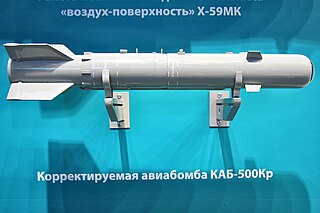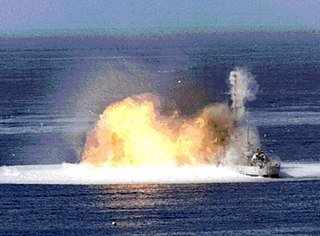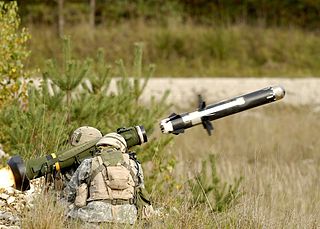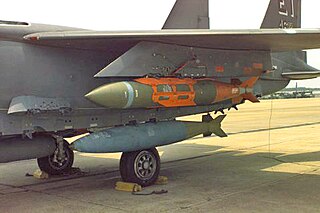KAB-1500 is a Russian precision guided weapon which comes in three versions: KAB-1500L, KAB-1500S-E and TV-guided KAB-1500KR. [1] [2] [3]
The 1500 name indicates the weapon weight class - 1.500 kilograms (about 3.300 lbs).

The AGM-65 Maverick is an air-to-ground missile (AGM) designed for close air support. It is the most widely produced precision-guided missile in the Western world, and is effective against a wide range of tactical targets, including armor, air defenses, ships, ground transportation and fuel storage facilities.

The KAB-500Kr is an electro-optical TV-guided fire and forget bomb developed by the Soviet Air Force in the 1980s. It remains in service with the CIS and various export customers.

The KAB-500L is a laser-guided bomb developed by the Soviet Air Force, entering service in 1975. It remains in service with the CIS and post-Soviet Russian Aerospace Forces.

A thermobaric weapon, also called an aerosol bomb, or a vacuum bomb, is a type of explosive munition that works by dispersing an aerosol cloud of gas, liquid or powdered explosive. The fuel is usually a single compound, rather than a mixture of multiple molecules. Many types of thermobaric weapons can be fitted to hand-held launchers, and can also be launched from airplanes.

An anti-tank guided missile (ATGM), anti-tank missile, anti-tank guided weapon (ATGW) or anti-armor guided weapon is a guided missile primarily designed to hit and destroy heavily armored military vehicles. ATGMs range in size from shoulder-launched weapons, which can be transported by a single soldier, to larger tripod-mounted weapons, which require a squad or team to transport and fire, to vehicle and aircraft mounted missile systems.

A bunker buster is a type of munition that is designed to penetrate hardened targets or targets buried deep underground, such as military bunkers.
The Mark 84 or BLU-117 is a 2,000-pound (900 kg) American general purpose aircraft bomb. It is the largest of the Mark 80 series of weapons. Entering service during the Vietnam War, it became a commonly used US heavy unguided bomb. At the time, it was the third largest bomb by weight in the US inventory behind the 15,000-pound (6,800 kg) BLU-82 "Daisy Cutter" and the 3,000-pound (1,400 kg) M118 "demolition" bomb. It is currently sixth in size due to the addition of the 5,000 lb (2,300 kg) GBU-28 in 1991, the 22,600 lb (10,300 kg) GBU-43/B Massive Ordnance Air Blast bomb (MOAB) in 2003, and the 30,000 lb (14,000 kg) Massive Ordnance Penetrator.

Paveway is a series of laser-guided bombs (LGBs).

A general-purpose bomb is an air-dropped bomb intended as a compromise between blast damage, penetration, and fragmentation in explosive effect. They are designed to be effective against enemy troops, vehicles, and buildings.

The BLU-109/B is a hardened bunker buster penetration bomb used by the United States Air Force. As with other "bunker busters", it is intended to penetrate concrete shelters and other hardened structures before exploding. In addition to the US, it is part of the armament of the air forces of Australia, Belgium, Canada, Denmark, France, Germany, Greece, Italy, Israel, Netherlands, Norway, Pakistan, Saudi Arabia, United Kingdom, and United Arab Emirates.

The S-8 is a rocket weapon developed by the Soviet Air Force for use by military aircraft. It remains in service with the Russian Aerospace Forces and various export customers.

The 9M123 Khrizantema is a Russian anti-tank guided missile (ATGM). Khrizantema was designed to deal with current and future generations of main battle tanks and can also be used to engage slow and low flying aerial targets like helicopters. The 9M123 missile, and its associated guidance system, forms the 9K123 missile system.

The Kh-29 is a Soviet air-to-surface missile with a range of 10–30 km. It has a large warhead of 320 kg, has a choice of laser, infrared, active radar or TV guidance, and is typically carried by tactical aircraft such as the Su-24, Su-30, MiG-29K as well as the Su-25, giving these aircraft an expanded standoff capability.

The Kh-59 Ovod is a Russian cruise missile with a two-stage solid-fuel propulsion system and 200 km range. The Kh-59M Ovod-M is a variant with a bigger warhead and turbojet engine. It is primarily a land-attack missile; the Kh-59MK variant targets ships.

A precision-guided munition (PGM), also called a smart weapon, smart munition, or smart bomb, is a guided munition intended to hit a specific target, to minimize collateral damage and increase lethality against intended targets. During the Persian Gulf War guided munitions accounted for only 9% of weapons fired, but accounted for 75% of all successful hits. Despite guided weapons generally being used on more difficult targets, they were still 35 times more likely to destroy their targets per weapon dropped.

The Mikoyan MiG-35 is a Russian multirole fighter that is designed by Mikoyan, a division of the United Aircraft Corporation (UAC). Marketed as a 4++ generation jet fighter, it is a further development of the MiG-29M/M2 and MiG-29K/KUB fighters. According to a Russian defense industry source, the Mikoyan MiG-35 is essentially an upgraded variant of the MiG-29KR. Many consider MiG-35 a new name given by Mikoyan for marketing. The first prototype was a modification of the aircraft that previously served as a MiG-29M2 model demonstrator given temporary name MiG-35 but a later prototype was a different model with different equipment that served as the base for the MiG-35 as is known today. Mikoyan first officially presented the MiG-35 internationally during the 2017 Moscow air show; the first two serial production aircraft entered service in 2019.
KAB-500 is a Russian precision guided weapon which comes in four versions:

KAB-1500L is a Russian precision guided weapon, part of KAB-1500 family, a laser guided bomb and also the current production standard for use on 4+ and 4++ generation fighter jets, like the Sukhoi Su-30MKI/Sukhoi Su-30MKK, Sukhoi Su-34 and Sukhoi Su-35. It is claimed to be the Russian equivalent to USA's Paveway II/Paveway III, though is a much larger device, at 6x the size. As the Paveway is 500lbs, it can generally be considered a closer match to the KAB-500L that uses similar guidance technology and is designed to hit railway, ammunition depots, railway terminals, highway bridges, military and industrial facilities, ships and transport vessels. The KAB-1500LG-F-E has an impact fuze which includes 3 different delay modes for target attack and it can also be mounted on older aircraft, like the Sukhoi Su-24 and the Mikoyan MiG-27.

The KAB-250 is a family of aerial bombs developed in the 2000s. It comes in two forms, the KAB-250LG-E laser-guided bomb and KAB-250S-E satellite-guided bomb. It is being introduced into service with the post-Soviet Russian Air Force since 2020. KAB stands for "Корректируемая Авиационная Бомба" which means "Managed (corrected) aircraft bomb" and refers to high-precision weapons.

The FAB-500 is a Soviet-designed 500-kilogram (1,100 lb) general purpose air-dropped bomb with a high-explosive warhead, primarily used by the Russian Aerospace Forces, former Soviet republics and customer countries. The original M-54 model was rolled out in 1954, shaped for internal carriage by heavy bombers, a low-drag M-62 version in 1962 was intended for fighter bomber external hardpoint carriage. Early models were unguided, with a single nose fuze, and compatible with most models of Soviet aircraft.